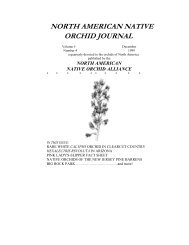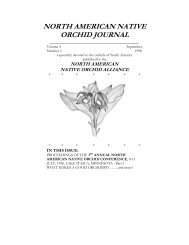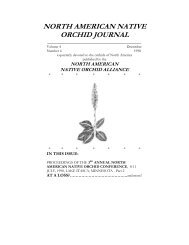north american native orchid journal - at The Culture Sheet
north american native orchid journal - at The Culture Sheet
north american native orchid journal - at The Culture Sheet
Create successful ePaper yourself
Turn your PDF publications into a flip-book with our unique Google optimized e-Paper software.
Brown & Folsom: WILD ORCHIDS OF THE WHITE MOUNTAINS OF NEW HAMPSHIRE AND MAINE<br />
SPIRANTHES is a cosmopolitan genus of about 50 species. Tre<strong>at</strong>ed in the strictest sense it is one of the most easily<br />
recognized genera, but has some of the more difficult plants to identify to species. <strong>The</strong> rel<strong>at</strong>ively slender, often<br />
twisted, stems and spikes of small white or creamy-yellow (or pink in S. sinensis) flowers are universally<br />
recognizable.<br />
Key to the ladies’-tresses, Spiranthes, found within the White Mountains region.<br />
1a plants mid-summer flowering; leaves present <strong>at</strong> flowering time; inflorescence loosely arranged; flower<br />
flowers spaced out, <strong>north</strong>erly in distribution.....<strong>north</strong>ern slender ladies’-tresses, Spiranthes lacera var.<br />
lacera<br />
1b plants l<strong>at</strong>e summer-autumn flowering...2<br />
2a plants of open shales and grasslands; flowers, ca. 5 mm long, usually arranged in a single rank.....Case’s<br />
ladies’-tresses, Spiranthes casei<br />
2b flowers larger, 8 mm or more in length...3<br />
3a lip constricted in the middle, panduriform.....hooded ladies’-tresses, Spiranthes romanzoffiana<br />
3b lip not constricted in the middle...4<br />
4a entire flower white and/or cream; l<strong>at</strong>eral sepals and petals appressed.....nodding ladies’-tresses,<br />
Spiranthes cernua<br />
4b flower creamy-white; l<strong>at</strong>eral sepals and petals approxim<strong>at</strong>e or divergent; lower surface of lip<br />
butterscotch colored.....yellow ladies’-tresses, Spiranthes ochroleuca<br />
Spiranthes casei C<strong>at</strong>ling & Cruise var. casei<br />
Case’s ladies’-tresses<br />
Range: Ontario east to Nova Scotia, south to Wisconsin, <strong>north</strong>ern<br />
Pennsylvania and western Maine<br />
In the White Mountains region: rare and local in the <strong>north</strong>ern areas<br />
Plants: terrestrial, 8-50 cm tall, sparsely pubescent below, inflorescence densely<br />
pubescent<br />
Leaves: 3-5; appearing basal or on the lower portion of the stem; linearoblanceol<strong>at</strong>e,<br />
up to 2 cm wide × 20 cm long; ascending to spreading; leaves<br />
present <strong>at</strong> anthesis<br />
Flowers: 10-50; in a spike, loosely spiraled with 5 or more flowers per cycle,<br />
nodding from the base of the perianth; floral bracts green; sepals lanceol<strong>at</strong>e;<br />
l<strong>at</strong>eral sepals slightly spreading; petals ov<strong>at</strong>e to oblanceol<strong>at</strong>e; perianth ivory<br />
or greenish-white; lip oblong, 5.0-7.5 mm, the central portion often a<br />
deeper creamy yellow, with thin, fringed margins, the apex trunc<strong>at</strong>e;<br />
overall flower size 5 (6-9) mm long<br />
Habit<strong>at</strong>: dry open sites usually on the Canadian Shield in shaley soils,<br />
road scrapes, or thin-soil grasslands<br />
Flowering period: l<strong>at</strong>e August to September<br />
Although plants had been known for many years, it was only in 1974 th<strong>at</strong><br />
they were described as a species. Formerly these plants were often known<br />
as the ―<strong>north</strong>ern (Spiranthes) vernalis’, a species th<strong>at</strong> grows considerably<br />
further to the south. For a short time plants of S. casei were also known as S.<br />
intermedia, again a totally different plant th<strong>at</strong> is actually a hybrid between S.<br />
vernalis and S. lacera var. gracilis and does not range <strong>north</strong>ward. Plants of S. casei, as<br />
253













